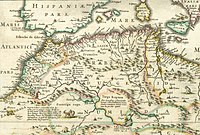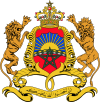This article needs additional citations for verification. (July 2024) |
| Berber Revolt | |||||||||
|---|---|---|---|---|---|---|---|---|---|
| Part of the Fitnas | |||||||||
| |||||||||
| Belligerents | |||||||||
| Umayyad Caliphate | Berber insurgents | ||||||||
| Commanders and leaders | |||||||||
|
Hisham ibn Abd al-Malik Ubayd Allah ibn al-Habhab Khalid ibn Abi Habib † Uqba ibn al-Hajjaj Kulthum ibn Iyad al-Qushayri † Abd al-Rahman ibn Habib Handhala ibn Safwan Balj ibn Bishr al-Qushayri Habib ibn Abi Ubayda † Tha'laba ibn Salama |
Khalid ibn Hamid Maysara al-Matghari Salim Abu Yusuf al-Azdi Ukkasha ibn Ayyub Abd al-Wahid ibn Yazid † | ||||||||
| History of Algeria |
|---|
 |
| History of Morocco |
|---|
 |
The Berber Revolt or the Kharijite Revolt[1] of 740–743 AD (122–125 AH in the Islamic calendar) took place during the reign of the Umayyad Caliph Hisham ibn Abd al-Malik and marked the first successful secession from the Arab caliphate (ruled from Damascus). Fired up by Kharijite puritan preachers, the Berber revolt against their Umayyad Arab rulers began in Tangier in 740, and was led initially by Maysara al-Matghari. The revolt soon spread through the rest of the Maghreb (North Africa) and across the straits to al-Andalus.
Although the Berbers managed to end Umayyad rule in the western Maghreb following the battles of Badgoura and of the Nobles, the Umayyads scrambled and managed to prevent the core of Ifriqiya (Tunisia, eastern Algeria and western Libya) and al-Andalus (Spain and Portugal) from falling into rebel hands, notably securing victory in the decisive battle of al-Asnam. However, the rest of the Maghreb was never brought back under Umayyad rule. After failing to capture the Umayyad provincial capital of Kairouan, the Berber rebel armies dissolved, and the western Maghreb fragmented into a series of small statelets, ruled by tribal chieftains and Kharijite imams.
The Berber revolt was probably the largest military setback in the reign of Caliph Hisham. From it emerged some of the first Muslim states outside the Caliphate.
- ^ Meri, Josef W. (2005-10-31). Medieval Islamic Civilization: An Encyclopedia. Routledge. p. 341. ISBN 978-1-135-45596-5.